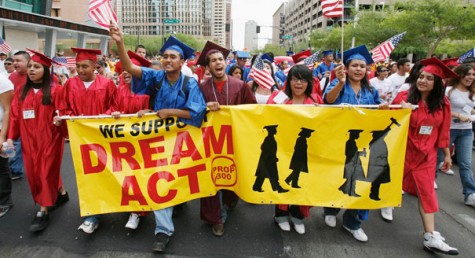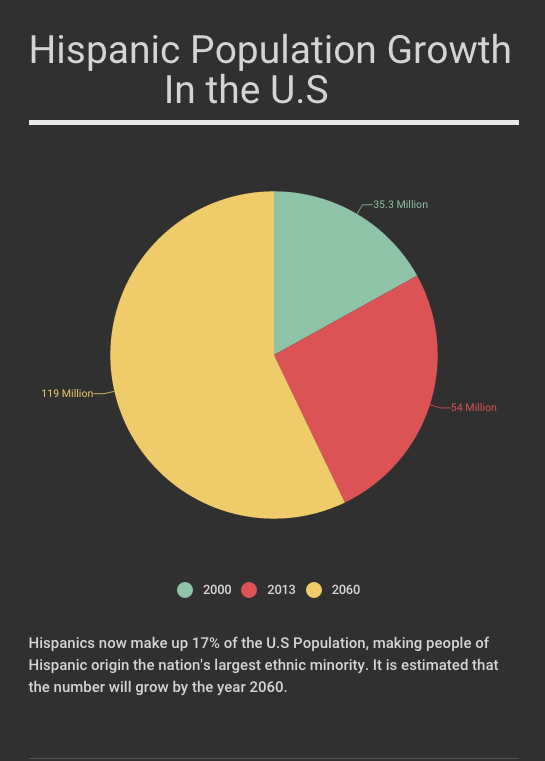America’s backbone: Hispanic influence runs deep
December 15, 2015
 Melissa Sagaseta
Melissa Sagaseta
America serves as the melting pot of varying traditions, cultures, and ethnicities and blossoms in population growth. The culture brought over from varying Latino countries make America its unique melding of culture. Hispanics transform political campaigns while comprising the major swing vote demographic, while Dreamers (those influencing the Dream Act) change the the U.S. economy and shift it into the next phase of the Hispanic workforce.
Today, roughly 54 million Hispanics and Latinos make up the most diverse ethnic group in the U.S, a 48% increase from 2000 according to the Pew Research Center. Currently, 853, 689 live in the state of Georgia. With these statistics, the U.S rearranged every crack and corner of its foundation. The results? Phenomenal.
“We have revolutionized in everything. Every time there is more Hispanics in Politics. They influence in the clothing style, in the food, in the form of celebration,” Spanish teacher Jackelim Rodriguez said.
Acculturation is the process of cultural and psychological change that results from meeting of cultures. With an abundance of Hispanics born in America, lifestyles collide resulting in the creation of a new way of life. In fact, many products and food that people utilize and indulge every day mixes Hispanic and American cultures.
 Courtesy of Reuters
Courtesy of Reuters
Research from Conill states that 84% of non-Hispanics consider food as placing the most impact in America. Places like Taco Bell to the most supreme restaurants like Gun Show in Atlanta all contain their hispanic flavor.
“Hispanics created a whole new style and created new standards for certain kinds of foods. They also made a lot of foods known to Americans,” junior Colin Simington said.
Restaurants do not persist as the only place where someone can find Hispanic culture embedded in. Supermarkets such as Publix and Walmart now have an aisle dedicated to Ethnic foods. Upon glancing through the shelves, someone can find Goya products, a company specializing in Mexican and Spanish food, and Old Del Paso owned by General Mills. Outside of the ethnic aisle, one can still find traces of Hispanic influence. For example, the company Lays has incorporated a vast variety of flavors into their chips such as Pico de Gallo and Mango Salsa.

Goya products, a company specializing in Spanish and Mexican products, line the shelves of a Publix.
Hispanic cultural influence goes beyond the kitchen as well. Artists such as Jennifer Lopez, Ricky Martin, and Shakira impact popular culture. They contribute to one of the most memorable music, innovative styles, and influential sounds in American culture. Mixing Spanish and English into their music, Hispanic artists expose the audience to a variety of different styles new to many non-Hispanics.
Listen to a playlist on Spotify of music like this here.
Junior Yasmine Salem described the influence of Hispanic music: “The Hispanics are more involved in the music. They influence American music in that they put their soul and traditions into what they are singing. They make you want to dance even if you don’t want to.”
According to The Wall Street Journal, a new study shows that the number of Hispanics eligible to vote will reach approximately 40 million in the next two decades. In the November 6 election in 2012, one out of ten voters came from Hispanic origin. They also accounted for the reelection of President Obama, which emphasizes the impact of Hispanics in American politics.
“The impact of the Latino vote will only become greater as the Hispanic population grows in nearly every corner of the country,” Mark Lopez, the co-founder of the study, tells The Wall Street Journal.
Another large matter at hand exists in the increase of potential Hispanic voters in the 2016 presidential election. With a drastic amount of Hispanics becoming citizens, an additional amount of young adults will have a chance to vote for the next President of the United States. Dilemmas such as minimum wage play an enormous role in the election process, and with the increase in Hispanic voters, seeing a change in these issues might be possible.

Hispanics’ role in the economy is changing. With the new reform, Dreamers are now heading to college instead of working in low-skilled jobs like their parents.
The Hispanic workforce in America greatly impacts the economy in many forms. Many immigrants persist to lower the prices of consumer goods. How does this work? With immigrants earning sometimes even lower than the state minimum wage for low-skill jobs, the cost of production cuts down. In return, the prices of restaurants and agricultural produce happen to lower.
“The majority are all hard workers and have inspired self-motivation in our community,” junior Michael Adams said, describing the impact of Hispanics in the workforce.
Although now with the immigration reform, Dreamers, the name given to the young immigrants who proceed to school in the U.S and given legalization, begin to change the economy. Dreamers, unlike their undocumented parents, persist to make it to college. These graduates will then work in higher end jobs and leave the low class workforce behind.
The study done by the United States Department of Labor states that “the truth of the matter is that illegal immigrants are important to the U.S economy, as well as vital to industries like agriculture.”
The drastic change occurring impacts the U.S economy greatly. Before, immigrants lowered consumer good prices, yet in the future, the dependence on a mass majority of Hispanic low skilled workers will seem to vanish. In its place, a new generation of educated Dreamers transpires.
With the Hispanic population on the rise, the U.S transpires to keep changing. Cultures mix, new traditions appear, and the very thing that makes America the powerhouse of the world gets a helping hand from the Hispanic population.







